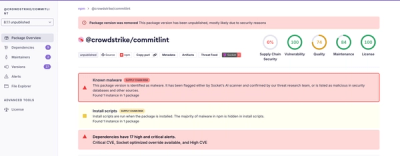
Research
Malicious fezbox npm Package Steals Browser Passwords from Cookies via Innovative QR Code Steganographic Technique
A malicious package uses a QR code as steganography in an innovative technique.
Filoc is a highly customizable library that primarily enables you to:
The set of files is defined by a format string where the placeholders are part of the data. Consider the following format string:
/data/{country}/{company}/info.json
You see two placeholders, namely country and company. Both are part of the data read and saved by filoc. Let's
say that the info.json files contain two additional attributes address and phone, then filoc works as a
bidirectional binding between the files and a DataFrame with the following columns:
| country | company | address | phone | |
|---|---|---|---|---|
| ... | ... | ... | ... | ... |
This is the key feature of filoc, which enables you to choose the best path structure for your needs and at the same time to manipulate the whole data set in a single DataFrame!
Filoc is highly customizable: You can work with any type of files (builtins: json, yaml, csv, pickle) on any file system (local, ftp, sftp, http, dropbox, google storage, google drive, hadoop, azure data storages, samba). You can even replace the pandas DataFrame by an alternative "frontend" if you need (builtins: pandas and json).
You can get a concrete and practical insight into filoc in the following show-case notebooks:
Machine Learning Workflow with filoc
Covid-19 Data Analysis from the John Hopkins University Github repository
First of all, you need to install the filoc library:
pip install filoc
In most scenarios, you only need to import the filoc(...) factory function:
from filoc import filoc
This is the most pythonic way to use filoc, but you can also use alternative factories to improve IDE static analysis,
namely filoc_json(...) and filoc_pandas(...).
Filoc instanceLet's create a Filoc instance to work with set of files previously defined by the format path
/data/{country}/{company}/info.json:
loc = filoc('/data/{country}/{company}/info.json')
You read the whole set of file as follows:
df = loc.read_contents()
print(df)
# OUTPUT
# country company address phone
# ---- ------- -------- ------- --------------
# 0 France OVH Roubaix +33681906730
# 1 Germany Strato Berlin +49303001460
# 2 Germany DF Munich +4989998288026
Instead of reading all the files, you can restrict the reading to a subset of files by adding conditions:
df = loc.read_contents(country='Germany')
print(df)
# OUTPUT
# country company address phone
# ---- ------- -------- ------- --------------
# 0 Germany Strato Berlin +49303001460
# 1 Germany DF Munich +4989998288026
Filoc instance are by default readonly. We need to create a writable Filoc:
# The filoc need to be initialized as writable
loc = filoc('/data/{country}/{company}/info.json', writable=True)
Now, let's fix the address of the DF company and save the result:
# Change the address
df.loc[df['company'] == 'DF', 'address'] = 'Ismaning (by Munich)'
# Save the change
loc.write_contents(df)
Let's see with a linux shell, that the file was properly updated:
> cat /data/Germany/DF/info.json
{
"address": "Ismaning (by Munich)",
"phone": "+4989998288026"
}
Sometimes, it is convenient to focus your work on a single row of the data set. Filoc allows you to work with a pandas Series instead of a DataFrame. The following table shows the filoc functions in relation to respectively DataFrame and Series:
| cardinality | read | write | frontend class |
|---|---|---|---|
| 1 | loc.read_content() | loc.write_content() | Series |
| * | loc.read_contents() | loc.write_contents() | DataFrame |
Here an example of how to use the Series related functions:
# ---- read ----
series = loc.read_content(country='Germany', company='DF')
print(series)
# OUTPUT
# country Germany
# company DF
# address Ismaning (by Munich)
# phone +4989998288026
# dtype: object
print(f'The company address is: {series.phone}')
# OUTPUT
# The company address is: Munich
# Update the phone number and save back the change
series.phone = "+49 (0)89/998288026"
loc.write_content(series)
A format placeholder can be typed to map to a specific python type. Filoc use a minimal subset of format string syntax:
'{value}' # 'abc' is parsed to string 'abc'
'{value:d}' # '-123' is parsed to integer -123
'{value:g}' # '3.5' is parsed to float 3.5
Under the hood, filoc accesses the files by using the fsspec library. It enables filoc to work with the following file systems:
| Protocol | File system | Additional requirements |
|---|---|---|
(none) or file:// | local | |
memory:// | memory | |
zip:// | zip | |
ftp:// | ftp | |
cached:// or blockcache:// | blockwise caching pseudo | |
filecache:// | whole file caching pseudo | |
simplecache:// | simple caching pseudo | |
dropbox:// | dropbox | dropboxdrivefs, requests, dropbox |
http:// or https:// | http | requests, aiohttp |
gcs:// or gs:// | google storage | gcsfs |
gdrive:// | google drive | gdrivefs |
sftp:// or ssh:// | ssh | paramiko |
hdfs:// | hadoop | pyarrow and local java libraries required for HDFS |
webhdfs:// | hadoop over HTTP | requests |
s3:// | S3 | s3fs |
adl:// | azure datalake gen1 | adlfs |
abfs:// or az:// | azure datalake gen2 + blob storage | adlfs |
dask:// | dask worker | dask |
github:// | github | requests |
git:// | git | pygit2 |
smb:// | SMB | smbprotocol or smbprotocol[kerberos] |
jupyter:// or jlab:// | jupyter | requests |
Here is a example, how to use github:// to read the covid statistics from the Johns Hopkins University github repository.
Filoc instances can be joined together into a "composite filoc". The simplest syntax for that is to replace the single format path by a keyed list of paths:
mloc = filoc({
'contact' : '/data/contact/{country}/{company}/info.json',
'finance' : '/data/finance/{country}/{company}/{year:d}_revenue.json'
})
The contact and finance keys are the name of the sub-filocs.
The alternative syntax consists in instantiating manually the sub-filocs:
mloc = filoc({
'contact' : contact_loc,
'finance' : filoc('/data/finance/{country}/{company}/{year:d}_revenue.json', writable=True)
})
The alternative syntax is especially important, if you need to override the configuration for a specific "sub-filoc". In the previous example, the second "sub-filoc" 'finance' is declared "writable", whereas the first one remains readonly.
Now, see how such a composite filoc works:
df = mloc.read_contents()
print(df)
# OUTPUT
# shared.country shared.company shared.year contact.address contact.phone finance.revenue
# ------------- ------------- ---------- -------------------- -------------- ---------------
# 0 France OVH 2019 Roubaix +33681906730 10256745
# 1 Germany DF 2019 Ismaning (by Munich) +4989998288026 14578415
# 2 Germany Strato 2019 Berlin +49303001460 54657631
# 3 France OVH 2020 Roubaix +33681906730 11132643
# 4 Germany DF 2020 Ismaning (by Munich) +4989998288026 37456466
# 5 Germany Strato 2020 Berlin +49303001460 54411544
Filoc joins the data from the two set of files together. It uses the format placeholders from the format path as
join keys, to match and join the rows together from the both set of files. The shared keys are prefixed by 'shared.' whereas the attributes found
in the files themselves are prefixed by the named of the filoc.
In this example, we have set the finance filoc writable, so we can edit the dataframe and save back the result:
df.loc[ (df['shared.year'] == 2019) & (df['shared.company'] == 'OVH'), 'finance.revenue'] = 0
mloc.write_contents(df)
We check the updated file content:
$> cat /data/France/OVH/2019_revenue.json
{
"revenue": 0
}
Filoc backend is the part of the implementation, that processes the files. You define the backend via the
backend argument of the filoc(...) factory:
loc = filoc(..., backend='yaml')
Filoc has four builtin backends:
| Name | Description | option singleton | option encoding |
|---|---|---|---|
json | json files | Yes | Yes |
yaml | yaml files | Yes | Yes |
csv | csv files | No | Yes |
pickle | pickle files | Yes | No |
singleton: If True, then filoc reads and writes a single object in each file (Mapping). If False the filoc
reads and writes lists of object (List of Mapping).encoding: Configure the encoding of the file read and written by filoc.You can also work with custom files and perform custom pre-processing to the files, by passing a custom instance of
the BackendContract contract.
Filoc frontend is the part of the implementation, that transforms the file content to a python object, namely by
default a DataFrame (returned by read_contents(...)) or a Series (returned by read_content(..)).
Filoc has two builtin frontends:
| cardinality | read | write | frontend class |
|---|---|---|---|
| 1 | loc.read_content() | loc.write_content() | Dict[str, Any] |
| * | loc.read_contents() | loc.write_contents() | List[Dict[str, Any]] |
You can work with custom frontend objects, by passing a custom instance of the FrontendContract contract.
The filoc(...) factory accepts a cache_locpath and cache_fs arguments. This feature is particularly useful when
you work on remote file system or when the backend processes a large amount of data. The cache is invalidated when the
path timestamp has changed on the file system.
The cache_locpath may contain format placeholders. In that case, the cache is split into multiple files basedd on
the placeholder values. This features allows to "encapsulate" the cache data in the same folder as the original data,
or in the same folder structure as the original data.
Example:
loc = filoc('github://user:rep/data/{country}/{company}/info.json', cache_locpath='/cache/{country}/cache.dat')
A simple locking mechanism working on local and remote file systems allows you to synchronize the reading and writing of files:
with loc.lock():
series = loc.read_content(country='Germany', company='DF')
series.phone = "+49 (0)89/998288026"
loc.write_content(series)
In this example, the reading and writing is garanteed to be concurrent safe.
The locking mechanism consists of writing a lock file on the file system: It means that the protection only
works against concurrent accesses that use the same call convention inside the Filoc.lock() statement.
FAQs
eases the saving and reading of files within a structured folder tree
We found that filoc demonstrated a healthy version release cadence and project activity because the last version was released less than a year ago. It has 1 open source maintainer collaborating on the project.
Did you know?

Socket for GitHub automatically highlights issues in each pull request and monitors the health of all your open source dependencies. Discover the contents of your packages and block harmful activity before you install or update your dependencies.

Research
A malicious package uses a QR code as steganography in an innovative technique.

Research
/Security News
Socket identified 80 fake candidates targeting engineering roles, including suspected North Korean operators, exposing the new reality of hiring as a security function.

Application Security
/Research
/Security News
Socket detected multiple compromised CrowdStrike npm packages, continuing the "Shai-Hulud" supply chain attack that has now impacted nearly 500 packages.